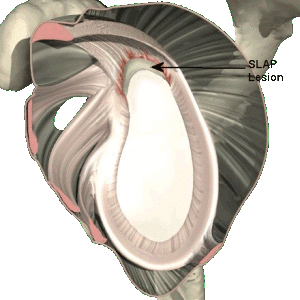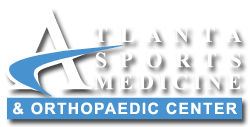SLAP Repair Protocol
 Arthroscopic Labral Repair Protocols (Type II, IV, and Complex Tears):
Arthroscopic Labral Repair Protocols (Type II, IV, and Complex Tears):
The purpose of this protocol is to provide the physician/therapist/patient with a GUIDELINE of the post-operative rehabilitation course for a patient with arthroscopic SLAP repairs.
Briefly, SLAP lesions have been classified as the following:
Type I SLAP lesions consist of degenerative fraying of the superior labrum but the biceps attachment to the labrum is intact. The biceps anchor is intact.
Type II SLAP lesions are created when the biceps anchor has pulled away from the glenoid attachment.
Type III SLAP lesions involve a bucket-handle tear of this superior labrum with an intact biceps anchor.
Type IV SLAP lesions involve a bucket-handle tear of the superior labrum in which the tear extends into the biceps tendon. The torn biceps tendon and labrum are displaced into the joint.
Complex SLAP lesions involve a combination of two or more SLAP types, usually II and III or II and IV.
Phase I- Immediate Post Surgical Phase – Protected motion phase (Weeks 1-4)
Goals:
• Protect the anatomic repair
• Prevent/minimize the side effects of immobilization
• Diminish pain and inflammation
• Sling for 6 weeks
• Wrist/ Hand active range of motion (AROM)/ Active Assisted Range of Motion (AAROM)
• Hand-gripping exercises
• PROM/AAROM:
-Flexion and elevation in the plane of the scapula to 70 degrees, week 2 to 80 degrees, week 3 to 90 degrees
-External rotation(ER)/internal rotation (IR) with arm in scapular plane
-ER to 20-30 degrees
-IR to 45°
• No AROM ER, extension, or abduction
• Submaximal isometrics for all rotator cuff, periscapular, and shoulder musculature
• No isolated biceps contractions (i. e. no active elbow flexion)
• Cryotherapy, modalities as indicated
• Discontinue use of sling at 4 weeks
• Initiate rhythmic stabilization drills within above ROM
Weeks 5-6
• Begin AROM of shoulder (all planes, gravity eliminated positions then gravity resisted position once adequate mechanics):
• Gradually improve PROM and AROM
o Flexion and elevation in the plane of the scapula to 145°
o Abduction to 145°
o External rotation 45-50° at 45° abduction
o Internal rotation 55-60° at 45° abduction
o Extension to tolerance
• May initiate gentle stretching exercises
• Gentle Proprioceptive Neuromuscular Facilitation (PNF) manual resistance
• Initiate prone exercise program for periscapular musculature
• Begin AROM elbow flexion and extension
• NO biceps strengthening
Phase II: Intermediate Phase-Moderate Protection Phase (Weeks 7-14)
Goals
• Gradually restore full AROM and PROM (week 10)
• Preserve the integrity of the surgical repair
• Restore muscular strength and balance
Weeks 7-9
• Gradually progress P/AROM
o Flexion, elevation in the plane of the scapula, and abduction to 180°
o External rotation 90-95° at 90° abduction
o Internal rotation 70-75° at 90° abduction
o Extension to tolerance
• Begin isotonic rotator cuff, periscapular, and shoulder strengthening program
• Continue PNF strengthening
• Initiate “Thrower’s Ten” program except resisted biceps exercise (see protocol)
• Type II repairs: begin sub maximal pain free biceps isometrics
• Type IV, and complex repairs: continue AROM elbow flexion and extension, no biceps isometric or isotonic strengthening
Weeks 10-12
• Progress ER P/AROM to thrower’s motion
o ER 110-115 at 90° abduction in throwers (weeks 10-12)
• Progress shoulder isotonic strengthening exercises as above
• Continue all stretching exercises as need to maintain ROM.
• Progress ROM to functional demands (i.e., overhead athlete)
• Type II repairs: begin gentle resisted biceps isotonic strengthening @ week 12
• Type IV, and complex repairs: begin gentle sub maximal pain free biceps isometrics
Phase III: Minimal Protection Phase (weeks 14-20)
Goals
• Establish and maintain full ROM
• Improve muscular strength, power, and endurance
• Gradually initiate functional exercises
Weeks 14-16
• Continue all stretching exercises (capsular stretches)
• Maintain thrower’s motion (especially ER)
• Continue rotator cuff, periscapular, and shoulder strengthening exercises
• Type II repairs: progress isotonic biceps strengthening as appropriate
• Type IV, and complex repairs: progress to isotonic biceps strengthening as appropriate
• “Thrower’s Ten” program with biceps exercise or fundamental exercises
• PNF manual resistance
• Endurance training
• Initiate light plyometric program
• Restricted sports activities (light swimming, half golf swings)
Weeks 16-20
• Continue all exercises listed above
• Continue all stretching
• Continue “Thrower’s Ten” program
• Continue plyometric program
• Initiate interval sport program (e.g. throwing). See interval throwing program
Phase IV: Advanced Strengthening Phase (Weeks 20-26)
Goals
• Enhanced muscular strength, power, and endurance
• Progress functional activities
• Maintained shoulder stability
Weeks 20-26
• Continue flexibility exercises
• Continue isotonic strengthening program
• PNF manual resistance patterns
• Plyometric strengthening
• Progress interval sports programs
Phase V: Return to Activity Phase (Months 6-9)
Goals
• Gradually progress sport activities to unrestrictive participation
• Continue stretching and strengthening program
1Wilk K, et all. Current Concepts in the Recognition and Treatment of Superior Labral (SLAP) Lesions. JOSPT 2005;35:273-291.
Protocol adopted from Brotzman & Wilk, published in Brotzman SB, Wilk KE, Clinical Orthopeadic Rehabilitation. Philadelphia, PA: Mosby Inc; 2003.
Protocol modified and used with permission from BWH Sports/Shoulder Service.
